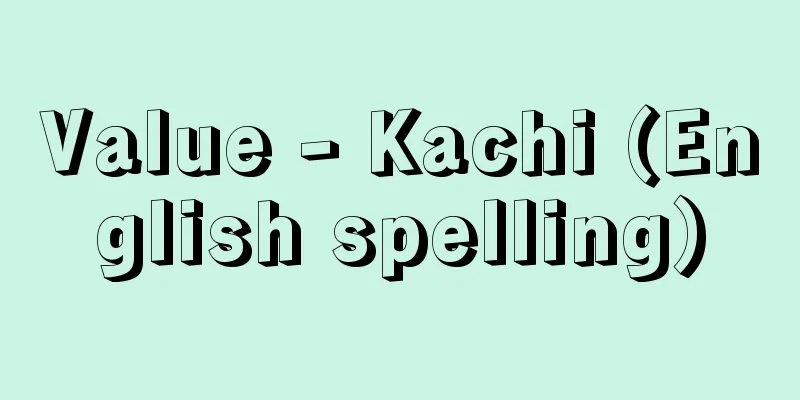Value - Kachi (English spelling)

|
Anything that satisfies our needs and desires and gives us satisfaction in our lives is considered to have value, and the most representative example of this is a commodity, in which case the value is economic value. However, apart from economic value, there are various other values. Even if they are not commodities, things that are comfortable for a person have comfort value for that person, and things such as health are valuable for life and have life value. Furthermore, things that give satisfaction to human mental activity include logical value (truth), moral value (goodness), aesthetic value (beauty), and religious value (holiness). This is especially clear in the case of spiritual values, but values in themselves do not exist apart from humans, like various other things. Values only come into existence when humans who perceive them exist. What is valuable to one person may not be valuable to another. Nevertheless, even if there are differences in what each person finds valuable, values such as truth, goodness, and beauty can be seen as existing objectively, regardless of whether each person recognizes them or not. Based on this, the neo-Kantian Rickert expressed the objectivity of value as "validity" (Gültigkeit), and established a value philosophy centered on valid values. In addition, Scheler, who belonged to the Phenomenology School and developed substantial value ethics, said that there is a hierarchy among various values, and showed the following criteria for determining the hierarchy: (1) the more permanent the value, (2) the more indivisible the value, (3) the more not based on other values, (4) the more deeply satisfying the value is when it is perceived, (5) the more not limited to the human sensibility. In other words, he said that life values are higher than comfort values, and spiritual values are higher than life values, and among spiritual values, religious values are the highest. According to Kant, things that satisfy human desires have a market price, and things that satisfy tastes have an emotional price, but these are both external and relative values that allow for the existence of equivalents, but in contrast, the humanity of each person, as far as it can be moral, has an internal and absolute value that cannot be replaced by anything. This value is "dignity" (Würde), and Kant, who emphasizes the dignity of the person, sees moral value as the highest value. [Yoshiaki Utsunomiya] Value in EconomicsPeople will not pay money to buy an object (good) unless they recognize that it has some economic value. In this case, what is actually paid is money equal to the price of the object, but that price is constantly fluctuating. In contrast, value is thought to be something that does not change unless there is a fundamental change in the object, something essential that lies behind the phenomenal price and regulates it. In economics, the theory of value was first developed as an essential or unified explanatory principle for the mechanism of price formation. When we talk about things (commodities), there are consumer goods and producer goods, and there are countless types of these, all with different uses and qualities. Nevertheless, everything is expressed and bought and sold with a uniform monetary price. Is it possible that at the root of all these heterogeneous things there is something homogeneous and common, and that is why they are expressed with a homogeneous monetary price? We would like to understand value as this homogeneous and common thing. This was the second requirement of the theory of value. The objective theory of value locates value that meets these two demands in broad terms, such as labor and production costs, while the subjective theory of value locates it in utility, that is, the quality that satisfies human desires. [Tetsuya Hitosugi] Objective value theoryAdam Smith, the founder of British classical economics, said that the word value has two different meanings; sometimes it represents the utility that the use of a thing gives to humans, and sometimes it represents the power of the ownership of a thing to purchase other goods. He called the former use value and the latter exchange value. Smith only pointed out the difference and relationship between the two using the example of water and diamonds, and ultimately explained value as exchange value, using the amount of labor. However, the amount of labor was not clear, as he said it was either the amount of labor invested (the amount of labor invested to produce a certain good) or the amount of labor commanded (the amount of labor that a certain good can command and purchase through exchange). In any case, Smith did not simply explain it in terms of the relationship between supply and demand, but instead sought some kind of cause at the base of the phenomenal fluctuations in market prices, sought to find it in labor, and tried to explain it internally and unified. This is the labor theory of value, which was particularly systematically developed by Ricardo in the classical school. However, Ricardo's labor theory of value was not necessarily consistent, and it took until Marx to resolve and overcome its theoretical weaknesses. On the other hand, the so-called cost of production theory, which also started from Smith and explains things by the prices of production factors, was developed by J. S. Mill and others. However, when we consider what unified principle of value explains the cost of production itself, this value theory also lacks consistency. [Tetsuya Hitosugi] Subjective value theoryIn the 1870s, C. Menger, W. S. Jevons, L. Walras and others developed a theory called the marginal utility theory or subjective value theory, which attempts to explain value from the perspective of desire or utility. They argued that the value of a good is not an inherent attribute of the good, but a judgment made by humans, and that the subjective value of one unit of a good is determined by the marginal utility of that good, and that the greater a person's desire for that good and the smaller the quantity of that good, the greater the subjective value. In other words, they argued that the value of a good is determined by the strength of the desire for that good and the amount of supply. The first problem with this theory is that, even if it can explain the value of consumer goods, it is unclear how to explain the value of producer goods, which humans do not expect to have any utility in themselves. In response to this, the explanation given is that producer goods produce consumer goods, so the subjective value given to the latter is reflected and attributed to the former. The second criticism was that it is impossible to measure desire and therefore utility, and that since the marginal utility of a good is determined by its price, explaining price from marginal utility is circular reasoning. In response to this, V. F. D. Pareto, who followed in Walras' footsteps, developed choice theory, which creates a theory by bypassing the measurement of utility, and further established a theoretical system that does not require the theory of value itself. Thus, today, with the exception of Marxian economics, the question of value is no longer a major issue in economic theory. [Tetsuya Hitosugi] Value in Marxian EconomicsIn Marxian economics, value is conceived as: In a commodity-producing society based on the social division of labor and private ownership of the means of production (commodity production reaches its highest level in capitalist society), the products of labor are exchanged as commodities. The private labor of individuals, carried out independently, forms social connections through the medium of commodity exchange. A commodity has two factors: use value and value. A commodity is a combination of these two factors. Use value is the usefulness of the commodity itself, which satisfies certain types of human desires through its respective attributes, whereas the value of a commodity can only appear in an exchange relationship with other commodities. Let us now take two commodities, rice and cotton cloth, and assume that they are exchanged at a ratio of "5 kilograms of rice = 1 bolt of cotton cloth." Why are rice and cotton cloth, two completely different items with different use values, exchanged at a fixed ratio? Exchange is impossible without equivalence, and for an exchange to take place, both must be reducible to a common third party. The third common thing that makes this exchange possible is value. So what is the substance of the value of a commodity? Rice and cotton cloth are completely different in terms of use value, so it is clear that use value is not something that they have in common. Therefore, in order to derive what is common to both, it is sufficient to abstract away use value. Then, what remains is the property that they are both products of labor, which they have in common. Rice is produced by agricultural labor, and cotton cloth by weaving labor, which are different concrete and useful labor. However, since the use value of commodities has been abstracted, the different concrete and useful forms of labor have already disappeared, and what remains is indiscriminate human labor, regardless of the form of labor expenditure, that is, the crystallization of abstract human labor, which is something that is common to both. This abstract human labor is the substance of value, and commodities have value because such human labor is expended in their production and is accumulated. So how is the value of a commodity measured? Since the substance of commodity value is the objectification of abstract human labor, its magnitude is measured by the quantity of labor, i.e., labor time. In a commodity-producing society, countless commodity producers are engaged in the production of the same use value, and their individual labor times vary, but what determines the magnitude of the commodity value is not these individual labor times, but the labor time that is socially and averagely necessary to produce that commodity. Only this socially necessary labor time is calculated as forming value. This socially necessary labor time is the labor time required to produce a certain use value under the existing social and standard production conditions and the social average degree of skill and intensity of labor, and it fluctuates with changes in labor productivity. When labor productivity increases, more use values are produced in the same amount of time than before, so the value of each unit of commodity decreases. Furthermore, the difference between simple labor and complex labor must be taken into account. The former is the expenditure of simple labor-power, which on the average every ordinary man possesses in his body without any special development; the latter is skilled labor. Complex labor is meaningful only as simple labor multiplied, and produces more value than simple labor in the same time. Thus the magnitude of the value of a commodity varies directly with the quantity of labor, and inversely with the productive power of labor. As is clear from the above definition of value, the value of a commodity is purely social. Therefore, as long as a commodity is the objectification of human labor, it has intrinsic value, and labor time is its intrinsic value measure, but it cannot express itself, but can only be expressed through the use value of other commodities. The commodity that ultimately monopolizes the role of the material for expressing the value of these commodities is gold, and gold becomes money as the general equivalent. Price is the expression of commodity value in a certain amount of the money commodity, gold. Although price, as an index of the magnitude of a commodity's value, is an index of the commodity's exchange relationship with money, this does not necessarily mean that it is an index of the magnitude of the commodity's value. In anarchic commodity production, supply and demand rarely match, so when demand exceeds supply, prices rise above value, and when supply exceeds supply, prices fall below value. In this way, prices constantly deviate from value due to fluctuations in the supply and demand relationship. However, in the long run and on average, prices tend to be attracted to and converge to value. Therefore, the law that value is determined by socially necessary labor time (the law of value) is maintained on average in the long run through the constant fluctuations in prices. [Nihei Satoshi] "Principles of Political Economy by C. Menger, translated by Yasui Takuma (1937, Nippon Hyoronsha)" ▽ "Karl Marx, Capital, Vol. 1, Part 1, translated by Hasebe Fumio (1954, Aoki Shoten)" ▽ "Karl Marx, Critique of Political Economy, translated by Takeda Takao et al. (Iwanami Bunko)" ▽ "Scheler's Collected Works, Vols. 1-3, Formalism and Substantial Value Ethics in Ethics, edited by Iijima Muneyoshi, Ogura Shisho, and Yoshizawa Denzaburo (1976-80, Hakusuisha)" ▽ "Essay on the Metaphysics of Morals by Kant, translated by Shinoda Hideo (Iwanami Bunko)" ▽ "E. V. Boehm-Bawerk, Fundamental Theory of the Value of Economic Goods, translated by Nagamori Yoshi (Iwanami Bunko)" [References] | | | |Source: Shogakukan Encyclopedia Nipponica About Encyclopedia Nipponica Information | Legend |
|
われわれが生活していくうえでの必要や欲望を満たし、われわれに満足を与えるものは、いずれも価値あるものとされるが、その代表は商品であり、その場合の価値は経済的価値である。だが、こうした経済的価値とは別に、さまざまな価値がある。商品ではなくても、ある人にとって快適なものは、その人にとって快適価値をもつし、健康といったものも生命にとって価値あるものであり、生命価値を備えている。さらには、人間の精神的活動に満足を与えるものとして、論理的価値(真)、道徳的価値(善)、美的価値(美)、宗教的価値(聖)などがあげられる。 精神的価値の場合にとくに明らかであるが、価値はそれ自体としては、さまざまな事物のように、人間を離れて実在しているわけではない。価値は、価値を感得する人間の存在をまって初めて存在する。またある人にとって価値あるものでも、他の人にとってそうではない場合もある。とはいえ、各人が何に価値をみいだすかに関して相違があるにしても、真善美といった価値そのものは、各人がそれを認めると認めないとにかかわらず、客観的に存立するとみることができ、そこから新カント学派のリッケルトは、価値の客観性を「妥当性」Gültigkeitという語で表現し、妥当する価値を中心とする価値哲学を樹立した。 また、現象学派に属し実質的価値倫理学を展開したシェラーは、さまざまな価値の間に高低の序列があるとし、(1)永続的な価値ほど高い、(2)分割できない価値ほど高い、(3)ほかの価値によって基礎づけられない価値ほど高い、(4)感得する際に与えられる満足の深い価値ほど高い、(5)人間の感性面に局限されない価値ほど高い、という序列決定の基準を示した。つまり快適価値よりも生命価値が、生命価値よりも精神的価値が高く、精神的価値のうちでは宗教的価値が最高であるとした。 なお、カントによると、人間の欲求を満たすものは市場価格をもち、趣味を満足させるものは感情価格をもつが、これらはいずれも外的で相対的な価値であり、等価物の存在を許すが、これに反して、道徳的でありうる限りでの各人の人間性は、何にも置き換えられない内的にして絶対的な価値をもつ。この価値が「尊厳」Würdeであって、人格の尊厳を強調するカントは、道徳的価値を最高の価値とみていることになる。 [宇都宮芳明] 経済学における価値人は物(商品)になんらかの経済価値を認めなければ、金を払って買おうとはしない。この場合、実際に支払うのは、その物の価格額だけの貨幣であるが、その価格は絶えず変動している。それに対して、価値は、その物に根本的な変化がない限り変化しないもの、現象的な価格の背後にあってそれを規制している本質的なもの、であると考えられる。経済学においては、まず第一に、この価格の形成機構の本質的ないし統一的説明原理として価値論または価値理論が展開された。 物(商品)といっても、消費財もあれば生産財もあり、さらにそれらに無数の種類があり、その用途も質もすべて異なる。にもかかわらずすべてが同質の貨幣価格によって表現され、売買される。この異質なものの根底に、なにか同質な共通なものがあるからこそ、同質な貨幣価格によって表現されるのではないか。この同質な共通なものとして価値をとらえたい。これが価値論の第二の要請であった。 この二つの要請を満たすものとしての価値を、労働、生産費など広義の費用に求めるのが客観価値説であり、それを人間の欲望を満たす性質つまり効用に求めるのが主観価値説である。 [一杉哲也] 客観価値説イギリス古典派経済学の創始者アダム・スミスは、価値ということばに二つの違った意味があり、ときには、その物の使用が人間に与える効用を表し、ときには、その物の所有が他の財貨を購買する力を表す、とする。そして、前者を使用価値、後者を交換価値とよんだ。スミスは、水とダイヤモンドの例をあげて両者の区別と関連を指摘したにとどまり、価値をもっぱら交換価値のことだとして、結局それを労働量によって説明した。もっとも、その労働量も、投下労働量(ある財の生産のために投下された労働量)であるとも、支配労働量(ある財が交換によって支配し購買しうる労働量)であるともいっており、明確ではなかった。ともかく、スミスは、単に需要供給の関係によって説明するのではなく、現象的な市場価格の変動の基礎になんらかの原因を追求し、それを労働に求め、内面的、統一的に説明しようとしたのである。これが労働価値説であり、古典学派においてはリカードによってとくに体系的に展開された。しかし、リカードの労働価値説もかならずしも首尾一貫していたわけではなく、その理論的弱点の解決と克服は、マルクスまでまたなければならなかった。 他方、同じくスミスを出発点として、生産要素の価格によって説明するいわゆる生産費説が、J・S・ミルらによって展開された。しかし生産費そのものがいかなる統一的価値原理によって説明されるのか、という点を考えると、この価値説も一貫性を欠くことになる。 [一杉哲也] 主観価値説1870年代には、欲望ないし効用の側から価値を説明しようとする限界効用学説あるいは主観価値説とよばれる学説が、C・メンガー、W・S・ジェボンズ、L・ワルラスらによって展開された。彼らは、財の価値は、財に固有の属性ではなく、人間が下す判断であり、ある財の一単位の主観的価値はその財の限界効用によって決定され、その財に対する人間の欲望が大きければ大きいほど、また財の数量が少なければ少ないほど、大きいとした。すなわち、財の価値は、その財に対する欲望の強さとその供給量によって定まるとしたのである。 この理論の第一の問題点は、消費財の価値は説明できるにしても、それ自体に人間が効用を感じないはずの生産財の価値を、どう説明するかという点にある。これに対しては、生産財が消費財を生産するのだから、後者に与えられる主観価値が前者に反映・帰属するという説明がなされる。 第二は、欲望したがって効用の測定は不可能であること、財の限界効用はその価格によって規定されるため、限界効用から価格を説明するのは循環論ではないか、などの批判である。これに対しては、ワルラスの流れをくむV・F・D・パレートによって、効用測定を迂回(うかい)して理論をつくる選択理論が展開され、さらに価値論そのものを必要としないとする理論体系が成立するようになる。 かくして今日では、マルクス経済学を除くと、価値の問題は、経済理論としてあまり問題にされなくなっている。 [一杉哲也] マルクス経済学における価値マルクス経済学においては、価値は次のように考えられている。 社会的分業と生産手段の私的所有に基づく商品生産社会(商品生産は資本主義社会において最高度の発展を遂げる)においては、労働生産物は商品として交換される。独立して営まれる個々人の私的労働は、この商品交換を媒介として社会的連関を取り結ぶのである。ところでこの商品は使用価値と価値という2要因をもつ。この2要因を統一したものが商品である。このうち使用価値は、それぞれの属性によって人間のなんらかの種類の欲望を満たすという商品自体に備わった有用性であるのに対して、商品の価値は、他の商品との交換関係のうちでしか現れえない。いま、米と綿布という任意の商品を取り上げ、これらが、「米5キログラム=綿布1反」という比率で交換されるものとしよう。米と綿布という使用価値のまったく異なったものが一定の比率で交換されるのはなぜか。交換は同等性なしにはありえないのであり、交換が行われる以上、両者は共通の第三者に還元されうるものでなければならない。この交換を成立させている第三の共通物が価値である。 では、商品の価値の実体はなにか。米と綿布とは使用価値としてはまったく異なったものであるから、使用価値が両者に共通なものでないことは明らかである。したがって、両者に共通なものを導き出すためには、使用価値を捨象してみればよい。そうすれば、そこに残るのは、両者に共通な労働生産物という性質である。米は農業労働、そして綿布は織物労働という相異なる具体的・有用的労働によって生産されたのであるが、商品の使用価値を捨象しているので、これらの労働の相異なる具体的・有用的形態はすでに消失し、そこには、労働の支出の形態にかかわりのない無差別な人間的労働、すなわち抽象的・人間的労働の結晶が、両者に共通なものとして残っている。この抽象的・人間的労働こそが価値の実体であり、商品は、その生産においてこのような人間的労働が支出され、それが堆積(たいせき)されているがゆえに価値をもつのである。 では、商品の価値の大きさはいかにして度量されるのか。抽象的・人間的労働の対象化が商品価値の実体であるがゆえに、その大きさは労働の分量すなわち労働時間によって度量される。商品生産社会においては無数の商品生産者が同一の使用価値の生産に携わっており、それらの個別的労働時間は異なるが、商品価値の大きさを規定するものは、そうした個別的労働時間ではなく、その商品を生産するのに社会的・平均的に必要な労働時間である。この社会的に必要な労働時間だけが価値を形成するものとして計算されるのである。この社会的必要労働時間とは、現存の社会的・標準的な生産諸条件と労働の熟練および強度の社会的な平均度とをもって、なんらかの使用価値を生産するために必要とされる労働時間であり、それは労働生産力の変動につれて変動する。労働生産力が上昇した場合、同じ時間内に以前よりもより多くの使用価値が生み出されるので、商品1単位当りの価値は低下する。さらに単純労働と複雑労働の相違も考慮しなければならない。前者は、平均的にだれでも普通の人間が特別の発達なしにその肉体のうちにもっている単純な労働力の支出であり、後者は、熟練を要する労働である。複雑労働は倍加された単純労働としてのみ意義をもち、同じ時間内に単純労働よりもより大きな価値を生み出す。このように一商品の価値の大きさは、労働の分量に正比例し、労働生産力に逆比例して変動する。 以上の価値規定から明らかなように、商品価値は純粋に社会的なものである。したがって、商品は人間的労働が対象化されている限り内在的な価値をもち、労働時間がその内在的価値尺度となるのであるが、それを自分では表現することができず、他の商品の使用価値によってしか表現されえない。このような諸商品の価値表現の材料としての地位を最終的に独占するようになった商品が金であり、このような一般的等価物の役割を果たすものとして金は貨幣となる。商品価値を貨幣商品=金の一定量で表現したものが価格である。商品の価値の大きさの指標としての価格は、その商品の貨幣との交換関係の指標であるとしても、そのことが必然的にその商品の価値の大きさの指標だとはかならずしもいえない。 生産が無政府性的に行われている商品生産のもとでは、需給が一致することはまれであるがゆえに、需要が供給を超過している場合には価格は価値以上に騰貴し、逆の場合には価格は価値以下に低下するというように、需給関係の変動によって価格は絶えず価値から乖離(かいり)しているからである。しかし長期的・平均的にみると、価格は価値に引き付けられ、それに収斂(しゅうれん)する傾向をもっている。したがって、価値が社会的必要労働時間によって規定されるという法則=価値法則は、価格の不断の変動を通して長期的・平均的に貫徹するのである。 [二瓶 敏] 『C・メンガー著、安井琢磨訳『国民経済学原理』(1937・日本評論社)』▽『カール・マルクス著、長谷部文雄訳『資本論』第1巻第1篇(1954・青木書店)』▽『カール・マルクス著、武田隆夫他訳『経済学批判』(岩波文庫)』▽『飯島宗享・小倉志祥・吉沢伝三郎編『シェーラー著作集第1~3巻 倫理学における形式主義と実質的価値倫理学』(1976~80・白水社)』▽『カント著、篠田英雄訳『道徳形而上学原論』(岩波文庫)』▽『E・v・ボェーム・バベルク著、長守善訳『経済的財価値の基礎理論』(岩波文庫)』 [参照項目] | | | |出典 小学館 日本大百科全書(ニッポニカ)日本大百科全書(ニッポニカ)について 情報 | 凡例 |
Recommend
Zhu Xi - I love you
A thinker from the Southern Song Dynasty in China...
Porter, G.
…In relation to reaction kinetics, a notable adva...
Kunene, M.
...It is noteworthy that writers in the post-colo...
Paralichthys olivaceus (English name) Paralichthysolivaceus
…In Japan, 10 species of the family Paralichthys ...
Omega Nautical Charts
...If a hyperbola based on another set of station...
Local Autonomy Law - Chiho Jichiho
Chapter 8 of the Constitution of Japan contains f...
Pollution prevention industry
An industry that manufactures equipment to prevent...
Lying Compulsion
〘 noun 〙 A pathological tendency to change the fac...
Kirishima Azalea - Kirishima Azalea
An evergreen shrub of the Ericaceae family (APG c...
Hyperbolic equation - soukyokugatahotei-shiki (English spelling) hyperbolic equation
A type of partial differential equation. The basic...
Asset approach
One of the exchange rate determination theories, i...
Grytviken
...Glaciers spread out from the central mountain ...
One million chantings of Nembutsu - One million chantings of Nembutsu
〘Noun〙① Chanting the name of Amida Buddha a millio...
Garnierite (garnierite)
A hydrous nickel-magnesium silicate mineral, a mem...
Concrete Mixer
…The agitator car used in tunnel construction is ...









